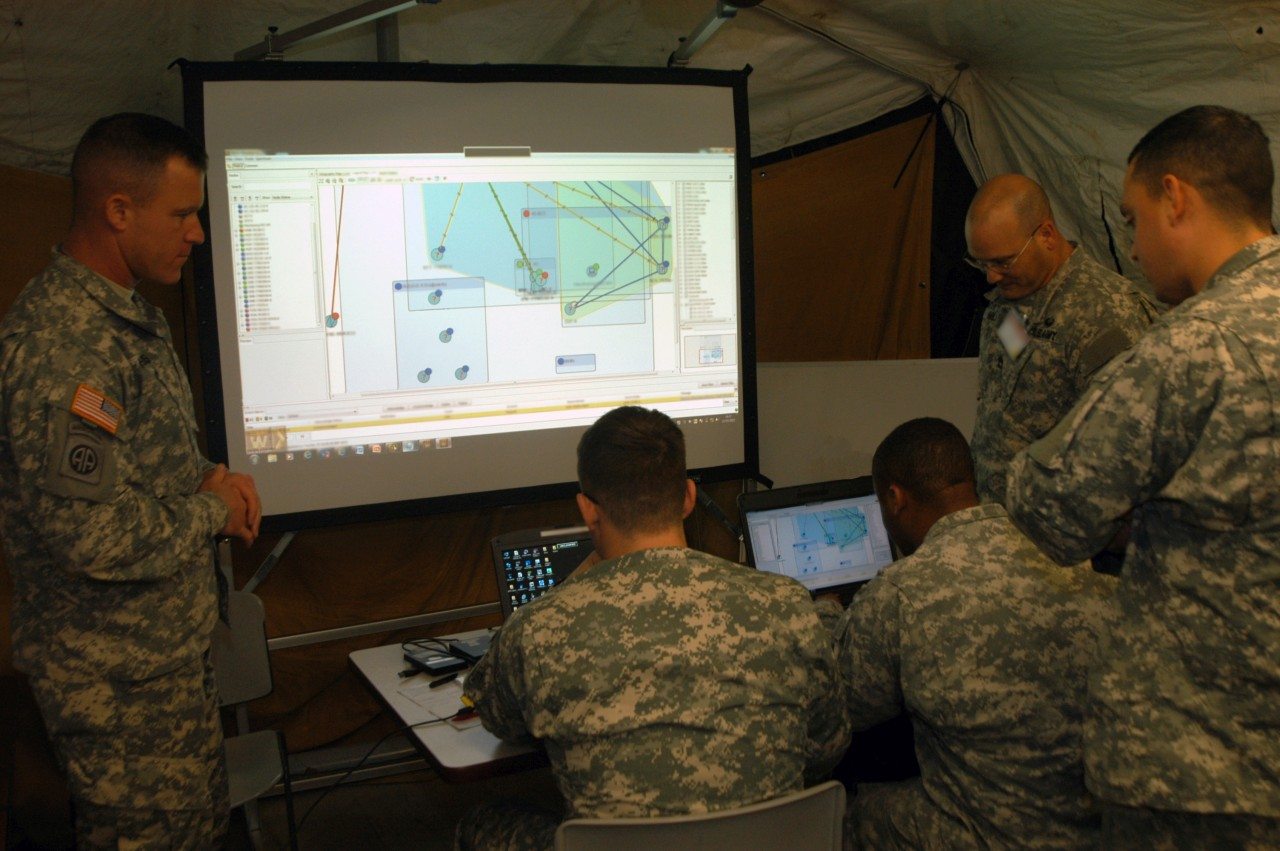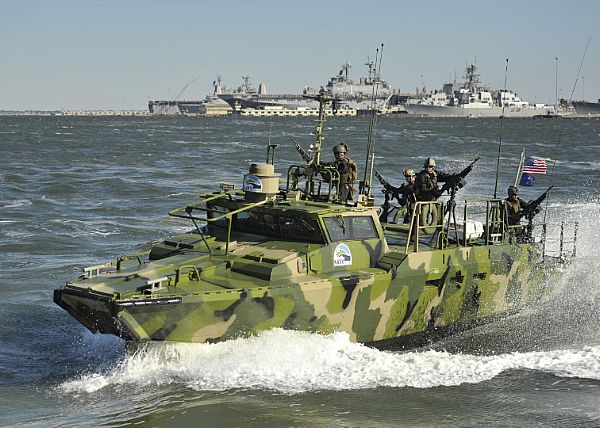To make it easier for Soldiers to manage the vast tactical communications network, the Army plans to operationally evaluate newly enhanced and simplified network operations, or NetOps, tools during Network Integration Evaluation, or NIE, 16.2 this spring.
The NetOps tool suite enables communications officers (S6s and G6s) and staff to provide a second set of eyes on the Army’s tactical communications network, Warfighter Information Network-Tactical, or WIN-T, ensuring Soldiers and commanders remain connected, communicating and synchronized.
“NetOps provides a picture of actual on-the-move network battlefield conditions at all times, so if there is any break in the communications it is known right away,” said Sgt. First Class, Jason Gourlie, satellite communications, or SATCOM, systems operator for the 101st Airborne Division, who supported recent NetOps testing. “Mission objectives can change at any given second and without proper communications, without that ability to reach back, there can be a delay in a commander’s on-the-spot battlefield decisions, which could [potentially] change the outcome of the mission or even cost lives.”
The WIN-T network is the tactical transport mechanism that delivers high-speed, high-capacity voice, video and data communications at every echelon throughout theater. It supports Soldiers in the command post, in networked vehicles traversing the battlefield or even early entry paratroopers seizing a remote airfield. WIN-T is the tactical network backbone to which other networked communication systems and mission command applications need to connect to function effectively. The Army’s suite of NetOps tools help Soldiers to configure, operate, monitor, troubleshoot and defend this immense network. The new NetOps enhancements simplify and increase visibility across the network to make these tasks easier, more efficient and effective.
The NetOps upgrades will be tested as part of the WIN-T Increment 3 follow-on operational test, or FOT, scheduled to be conducted during NIE 16.2 this spring on Fort Bliss, Texas, and White Sands Missile Range, New Mexico. As part of an extensive effort to reduce risk for the FOT, the Army recently tested the new NetOps improvements during the WIN-T Increment 3 functional qualification test #3, or FQT3, supported by Soldiers from the 101st Airborne Division and 10th Mountain Division, at the contractor facility in Taunton, Massachusetts.
The contractor’s in-plant test bed environment mirrored an operational WIN-T network environment using actual WIN-T Increment 2 equipment and vehicles. The Army will perform additional risk reduction testing at its own emulation test bed at Aberdeen Proving Ground, Maryland, to further prepare for NIE 16.2. A successful test at the NIE will support the new NetOps software technical insertion into the WIN-T network, projected for fiscal year 2017.
“The functional qualification test highlights the synergy between PM WIN-T, the Army Test and Evaluation Command [ATEC] and industry,” said Col. Greg Coile, project manager for WIN-T. “These three entities teamed early in the testing process to ensure that all the proper testing procedures and instrumentation were in place to increase efficiencies in time and cost by reducing risk for the operational test at NIE 16.2 this spring.”
The new NetOps simplifications also improve defensive cyber visualization to help signal Soldiers more easily manage and protect the network. The WIN-T Inc 3 FQT3 included the implementation of Public Key Infrastructure, or PKI, in the tactical formation. PKI supports the distribution and identification of public encryption keys, enabling users and systems to securely exchange data over networks and verify the identity of whom they are communicating. It provides assured identity for personnel and non-personnel entities, and prevents unauthorized systems and services from connecting to the network. It also reduces system complexity by reducing the number of passwords needed to manage the network.
The Army continues to listen to Soldier feedback from theater, user juries and test events to make WIN-T NetOps, systems and user interfaces more intuitive and easier to operate. System simplification increases equipment and network “up-time” through the reduction of human error while reducing task completion time and training requirements. Recent simplification improvements include enhancements to the troubleshooting and preventative maintenance tools that alert operators of potential network equipment problems.
“The biggest benefit [of the upgrades] is the increased usability piece of the NetOps tools and the enhancement of monitoring capabilities,” said Chief Warrant Officer 3 Charles Coker, instructor at the Army’s Cyber Center of Excellence. “It provides NetOps personnel with a robust software solution for better management of the network and it also allows Soldiers to probe into the network to troubleshoot connectivity issues. The user interface is easy to circumnavigate as the tools provide you step-by-step guidance towards planning, installing and managing your unit’s tactical network. Now that we have that capability, planning, establishing and sustaining a tactical communications network for future missions is more easily attainable.”
WIN-T NetOps provides the big picture of the network so communications officers and staff can better manage network resources, fix breaks in connectivity faster or even before they may happen, and improve network visibility to better defend the network against cyber-attacks. Going forward, the Army will continue to make NetOps more user-friendly, providing a consistent look and feel across the various WIN-T configuration items to minimize training impact and reduce Soldier burden.
“I have used the previous NetOps before and this version has gotten more powerful,” said Sgt. 1st Class Jean Burgosdeleon, tactical command post platoon sergeant for the 101st Airborne Division. “It helps with quicker setup of equipment and adds more capability. The S6 shop can monitor your network and actually inform you when something goes down. When you are engaged with something else, it’s like having a second set of eyes on your equipment. It is providing a [definite] edge.”
Both the at-the-halt and on-the-move increments of WIN-T will share a common NetOps for more seamless interoperability, easy monitoring and a reduction in training requirements. The new NetOps software enhancements are also helping to pave the way for the convergence of the NetOps tools and management for both the upper tactical internet (WIN-T) and the lower tactical internet (radio networks). The goal of NetOps convergence is to provide one tool, or an easy to use integration of tools, into a single seamless delivery so that the S6 has one tool set to more easily see and manage the entirety of the network. The S6 will be able to see all the many facets of the network in one cohesive picture, said Lt. Col. (P) Ward Roberts, product manager WIN-T Increment 3, which manages the WIN-T NetOps.
“As the Army continues to add more capability to the network to ensure Soldiers at every echelon remain connected and engaged, all of this technology, this unified network of capability, has to be managed,” Roberts said. “By converging and simplifying NetOps across all those command posts, networked vehicles and radio networks, we gain power and a stronger foothold on the network and on our enemies.”











